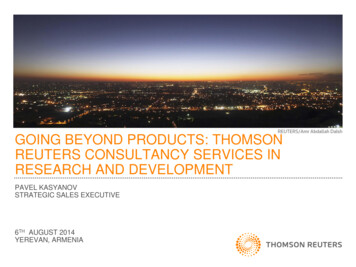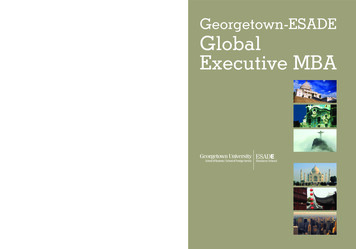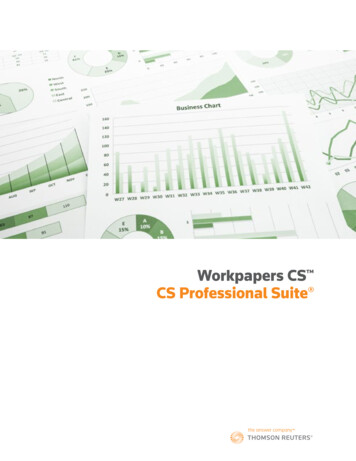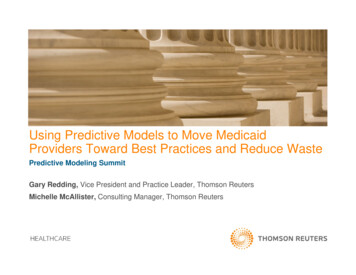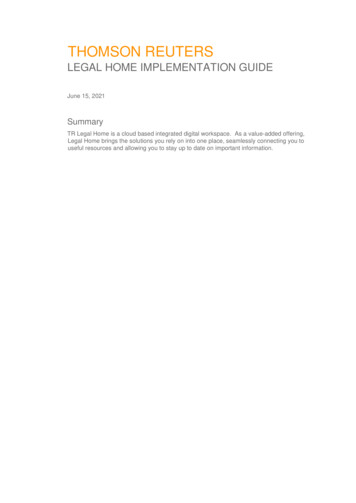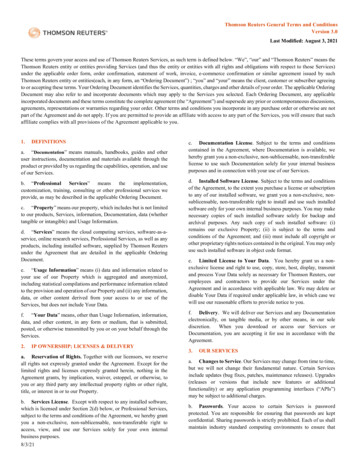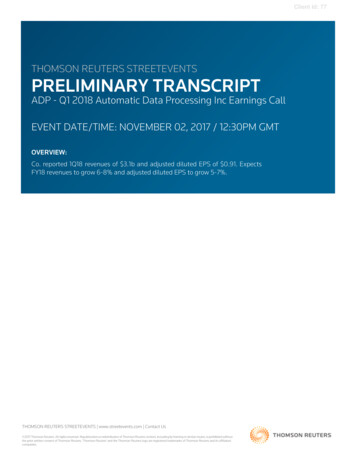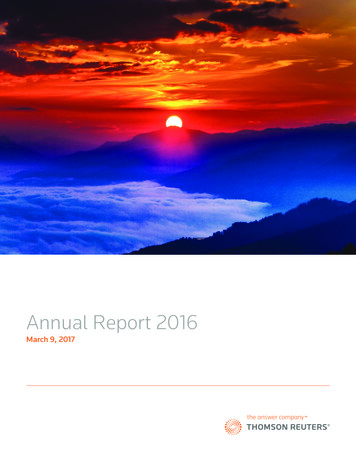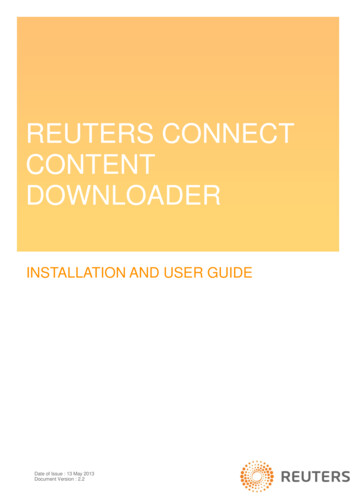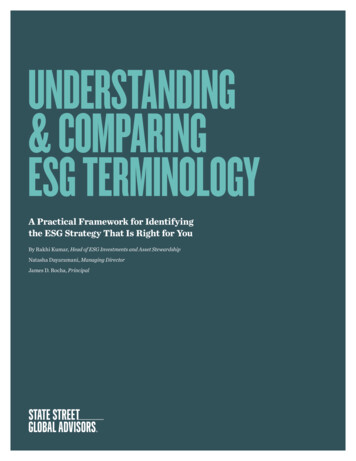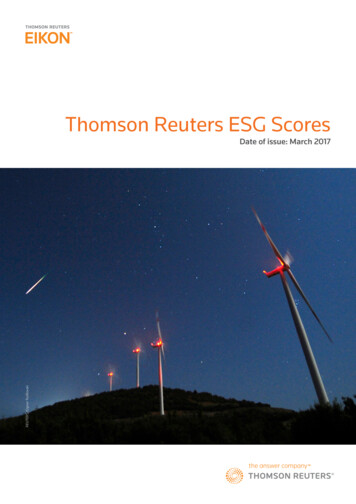
Transcription
Thomson Reuters ESG ScoresREUTERS/Ognen TeofilovskiDate of issue: March 2017
Thomson Reuters ESG ScoresContentsExecutive Summary . 3Data Process .4Global Coverage .5Scores Overview .6Scores Structure .6Scores Calculation Methodology.8Score Availability and Delivery.9Data and Scores Update Frequency .9Appendix . 102
Thomson Reuters ESG Scores3Executive SummaryInvestors have long recognized thatenvironmental, social and governance (ESG)factors are important measures for companyvaluation, risk management and evenregulatory compliance. Now we are seeingmore and more managers incorporating ESGinto their asset allocation process, utilizing aholistic approach in a more holistic way, as wellas more thematic investment vehicles emergingthat appeal to investors who have specificinvestment objectives.With Thomson Reuters you can easily integrate ESGfactors into portfolio analysis, equity research, screening orquantitative analysis. We offer users the possibility to combineand analyze ESG data using cutting-edge applications forin-depth analysis.The Thomson Reuters ESG Scores were designed totransparently and objectively measure a company’s relativeESG performance across ten themes (emissions, environmentalproduct innovation, human rights, shareholders, etc.) based oncompany reported data. We also provide an overall score whichis discounted for ESG controversies that materially impact thecorporations. The scores are available on over 6,000 companiesglobally. They are simple to understand percentile rankscores (available in both percentages and letter grades fromD- to A ) benchmarked against TRBC Industry Group for allEnvironmental and Social categories, and against the Countryfor all Governance categories.Thomson Reuters ESG scores, an enhancement andreplacement to the existing ASSET4 ratings, reflect our strategicESG framework, and are a robust indicator of companies’ ESGperformance where company size and transparency biases areminimal. Key enhancements over the legacy equal weightedASSET4 ratings are:1 ESG controversies overlay2 Industry and Country benchmarks at the data pointscoring level3 Automatically adjusted Category scores based on thesize and impact of each category4 Percentile Rank scoring methodology where hiddenlayers of calculations are eliminatedThomson Reuters offers one of the most comprehensiveESG databases in the industry covering over 6,000 publiccompanies, across more than 400 different ESG metrics, withhistory going back to 2002.COMPANY OVERVIEWPILLARSCATEGORIESINDICATORSDATA POINTSENVIRONMENTALSOCIAL RESOURCE USE EMISSIONS INNOVATION WORKFORCE HUMAN RIGHTS COMMUNITY PRODUCT RESPONSIBILITYGOVERNANCE MANAGEMENT SHAREHOLDERS CSR STRATEGYMORE THAN 70 KEY PERFORMANCE INDICATORS (KPI) (CALCULATED FROM DATA POINT VALUES)MORE THAN 400 DATA POINTS
Thomson Reuters ESG ScoresThomson Reuters ESG Data ProcessWith over 150 content research analysts that are trained to collect ESG data, we have one of the largest ESG content collectionoperations in the world. With local language expertise and operating from different locations across the globe, we process numerouspublicly available information sources with the aim of providing up to date, objective and comprehensive coverage. There are over 400ESG measures, which our analysts process manually for each company within the Thomson Reuters ESG universe, with each measuregoing through a careful process to standardize the information and guarantee it is comparable across the entire range of companies.The database is updated on a continuous basis with data refreshed on products every 2 weeks, which includes the recalculationof the ESG scores. Updates could include a brand new company being added to the database, the latest fiscal year update or theinclusion of a new controversy event.Data quality is a key part of the collection process which is why we use a combination of both algorithmic and human processes to makesure we achieve as close to 100% data quality as possible. Below is an overview of the various methods we use to achieve this goal.4
Thomson Reuters ESG Scores5Thomson Reuters ESG Global CoverageThomson Reuters ESG universe of companies for which ESG data is maintained and ESG Scores are calculated consists of 6,000 public companies globally. Regional breakdown is provided in the illustration below:Asia(ex-Japan)700 NorthAmerica2,300 Europe1,400 Japan460 Africa andMiddle East200 Oceania550 LATAM180 Our coverage has evolved over time and is continuously expanding as we include more indices. Semi annually, we review theconstituents of these indices and add any newly included companies to our coverage. We are in the process of adding all Russell2000 Index companies to the coverage, with a tentative completion date of Q1 2018. The illustration below shows a timeline of theindex inclusion in the Thomson Reuters ESG universe.BovespaS&P ASX 300S&P NZX 5020132016MSCI EmergingMarkets20112009S&P/TSXCOMPOSITE2012Russell 1000DJ STOXXMSCI World20082003SMIDAXCAC 40FTSE 100FTSE 250S&P 500NASDAQ 100
Thomson Reuters ESG Scores6Thomson Reuters ESG Scores OverviewThomson Reuters ESG Scores are an enhancement andreplacement to the existing equally weighted ASSET4 ratings.They are a representation of our strategic ESG frameworkand were designed to transparently and objectively measurecompany’s relative ESG performance across ten main ESGthemes. The ten ESG categories make up the overall ESG Scorewhich is also overlaid with ESG Controversies score to derivea comprehensive ESGC Score. The underlying measures aregranular enough to differentiate effectively between companiesthat report some issues on a high level but lack proof of actualimplementation and execution, versus companies that “walkthe talk” and emerge as leaders in their respective industriesor regions.Thomson Reuters ESG scores are calculated and available forall companies and historical fiscal periods in the ESG GlobalCoverage. In other words, historical ESG Scores are availablegoing back to fiscal year 2002 for approximately 1,000companies (mainly US and European).There are two overall ESG Scores calculated per company, perfiscal year in the model:asuG me res colSle E12820Thomson Reuters captures and calculates over 400 companylevel ESG measures, of which we have carefully selected asubset of 178 most relevant data points to power the overallcompany assessment and scoring process. The underlyingmeasures are based on considerations around materiality, dataavailability, and industry relevance.They are grouped into 10 categories. A combination of the10 categories formulates the final ESG score, which is areflection of the company’s ESG performance based onpublicly reported information.Resource UseInnovationGovernancem29a n y p u b li c dure19liscosfr omp8Thomson Reuters ESG Score (ESG Score)ManagementShareholders1214The model is fully automated and transparent which makesit free from subjectivity and hidden calculations or inputs.EmissionsESGScorecoThomson Reuters ESG Scores StructureEnvironmental2234The availability of both evaluations allows users to adoptand apply the score that meets their process, assessment orinvestment criteria.dcte4001 Thomson Reuters ESG Score – measures a company’s ESGperformance based on reported data in the public domain2 Thomson Reuters ESG Controversy (ESGC) Score –overlays the Thomson Reuters ESG Score with ESGcontroversies to provide a comprehensive evaluationon the company’s sustainability impact and conduct.Category scores and definitions can be found in the appendix.CSR StrategySocialWorkforceHuman RightsCommunityProduct Responsibility
Thomson Reuters ESG Scores7Thomson Reuters ESG Controversy Score (ESGC score)The ESGC Scores provide a rounded and comprehensiveevaluation of a company’s ESG performance based on thereported information in the ESG pillars with an ESG controversiesoverlay captured from global media. The main objective ofthis score is to discount the ESG performance score based onnegative media stories as it increases the impact of significant,material ESG controversies in the overall ESGC score.Company reportsThomson Reuters ESG Data (400 measures)The ESGC Scores are calculated as the weighted averageof the two component scores per fiscal period, with recentcontroversies being reflected in the latest complete period.ESG Controversies CategoryThe ESG Controversy Category Score is calculated basedon 23 ESG controversy topics (the list of which is availablein the appendix) and measures a company’s exposure toenvironmental, social and governance controversies andnegative events reflected in global media. During the year, ifa scandal occurs, the company involved is penalized and thisaffects their overall ESGC scores and grading. The impact ofthe event may still be seen in the following year if there arenew developments related to the negative event, for examplelawsuits, ongoing legislation disputes or fines. All new mediamaterials are captured as the controversy progresses.All Controversy scores are fully automated and objective.We calculate an aggregated controversy percentile rank acrossE, S and G, using all 23 controversy topics.Easily identify companies with strong ESG practicesor exposure to ESG risksThomson Reuters ESG Scores are available on ThomsonReuters Eikon for seamless integration into users’ workflows.They are accessible via the new ESG company views, theScreener App, Eikon for Office and Portfolio Analytics App. Thenew ESG views render the percentage scores to letter gradesto interpret quickly how companies are performing relativeto their peers and where a company’s ESG weaknesses andstrengths lie.The conversion from a score to a letter grade is based on thelogic to the right:ESG Score comprised of 178 Critical ESG MeasuresEnvironmentalSocialGovernanceESG Controversies Category23 controversy measuresTOTAL Thomson Reuters ESGC ScoreScore RangeGrade0.0 score 0.083333D-0.083333 score 0.166666D0.166666 score 0.250000D 0.250000 score 0.333333C-0.333333 score 0.416666C0.416666 score 0.500000C 0.500000 score 0.583333B-0.583333 score 0.666666B0.666666 score 0.750000B 0.750000 score 0.833333A-0.833333 score 0.916666A0.916666 score 1A
Thomson Reuters ESG Scores8Thomson Reuters ESG Scores Calculation MethodologyThomson Reuters ESG Scores calculation methodology is described in the section below.1 Category Scores CalculationPercentile Rank scoring methodology is adopted to calculate the 11 category scores. It is based on three factors: How many companies are worse than the current one? How many companies have the same value? How many companies have a value at all?Percentile rank score is based on the rank, and therefore it is not very sensitive to outliers. The distribution of the scores generatedwith percentile rank score is almost flat, for this reason average and standard deviation of the scores generated with percentile rankscore are not overly useful.score n. of companies with the same value included the current one2n. of companies with a valuen. of companies with a worst value Each category score is the equally weighted sum of all the indicators used to create it. The normalized weights are calculatedexcluding indicators with no data available in the public domain.2 Category Benchmarks3 Category WeightsTo calculate the Environmental and Social category scores,we have used the TRBC Industry Group as the benchmarkbecause such issues tend to be more relevant and similar tocompanies within the same industries.To calculate the overall Thomson Reuters ESG Score, we haveapplied an automated, factual logic that determines the weightof each category.To calculate the Governance categories, we have used countryas the benchmark because best governance practices tend tobe more consistent within countries.The driver is the number of measures that make up a categoryin comparison to all indicators used in the TR ESG Scoreframework. As a result categories that contain multiple issueslike Management (composition, diversity, independence,committees, compensation, etc.) will have higher weight thanlighter categories such as Human Rights.Each category consists of a different number of measures. Thecount of measures per category determines the weight of therespective category. Detailed counts and weights are providedin the table below:PillarCategoryIndicators in ScoringWeightsEnvironmentalResource %Human Rights84.50%Community148%Product SR Strategy84.50%178100%SocialGovernanceTOTAL
Thomson Reuters ESG ScoresThomson Reuters ESG Score Availability and DeliveryThomson Reuters ESG Scores are available through Thomson Reuters Eikon for easy integration into your workflow.Bulk feed delivery will be released later in the year.Thomson Reuters ESG Data and Scores Update FrequencyAll ESG data and scores are updated annually based on fiscal year and aligned with corporate reporting patterns. We refresh datamore frequently in exceptional cases, when there is a significant change in the reporting or corporate structure during the year.ESG news and controversies are updated on a continuous basis as and when such events occur and get picked up by global media.All updated ESG data is refreshed, in products, on a bi-weekly basis which triggers the recalculation of the analytics and scores.9
Thomson Reuters ESG Scores10AppendixCATEGORY SCORESThe table below lists the Category scores and their definitions:ScoreDefinitionTRESG Resource Use ScoreThe Resource Use Score reflects a company’s performance and capacity to reduce the useof materials, energy or water, and to find more eco-efficient solutions by improving supplychain management.TRESG Emissions ScoreThe Emission Reduction Score measures a company’s commitment and effectivenesstowards reducing environmental emission in the production and operational processes.TRESG Innovation ScoreThe Innovation Score reflects a company’s capacity to reduce the environmental costsand burdens for its customers, and thereby creating new market opportunities throughnew environmental technologies and processes or eco-designed products.TRESG Workforce ScoreThe Workforce Score measures a company’s effectiveness towards job satisfaction,a healthy and safe workplace, maintaining diversity and equal opportunities, anddevelopment opportunities for its workforce.TRESG Human Rights ScoreThe Human rights category score measures a company’s effectiveness towards respectingthe fundamental human rights conventions.TRESG Community ScoreThe Community Score measures the company’s commitment towards being a goodcitizen, protecting public health and respecting business ethics.TRESG Product Responsibility ScoreThe Product Responsibility Score reflects a company’s capacity to produce quality goodsand services integrating the customer’s health and safety, integrity and data privacy.TRESG Management ScoreThe Management Score measures a company’s commitment and effectiveness towardsfollowing best practice corporate governance principles.TRESG Shareholders ScoreThe Shareholders Score measures a company’s effectiveness towards equal treatmentof shareholders and the use of anti-takeover devices.TRESG CSR Strategy ScoreThe CSR Strategy Score reflects a company’s practices to communicate that it integratesthe economic (financial), social and environmental dimensions into its day-to-daydecision-making processes.
Thomson Reuters ESG ScoresCONTROVERSY MEASURESList of all controversy measures that make up the ESG Controversy Category ScoreCategoryName (n)Label (l)Description ion ControversyNumber of controversies published in the media linked to anti-competitivebehavior (e.g., anti-trust and monopoly), price-fixing or s Ethics ControversiesNumber of controversies published in the media linked to business ethics ingeneral, political contributions or bribery and al PropertyControversiesNumber of controversies published in the media linked to patents and intellectualproperty Critical CountriesControversiesNumber of controversies published in the media linked to activities in critical,undemocratic countries that do not respect fundamental human rights principles.CommunityTR.ControvPublicHealthPublic Health ControversiesNumber of controversies published in the media linked to public health orindustrial accidents harming the health & safety of third parties (non-employeesand non-customers).CommunityTR.ControvTaxFraudTax Fraud ControversiesNumber of controversies published in the media linked to tax fraud, parallelimports or money laundering.Human RightsTR.ControvChildLaborChild Labor ControversiesNumber of controversies published in the media linked to use of child labor issues.Human RightsTR.ControvHumanRightsHuman Rights ControversiesNumber of controversies published in the media linked to human rights issues.ManagementTR.ControvMgtCompMgt CompensationControversies CountNumber of controversies published in the media linked to high executiveor board compensation.Product ResponsibilityTR.ControvConsumerConsumer ControversiesNumber of controversies published in the media linked to consumer complaints ordissatisfaction directly linked to the company’s products or services.Product ResponsibilityTR.ControvCustomerHSControversies CustomerHealth & SafetyNumber of controversies published in the media linked to customer health & safety.Product ResponsibilityTR.ControvPrivacyControversies PrivacyNumber of controversies published in the media linked to employee or customerprivacy and integrity.Product ResponsibilityTR.ControvProductAccessControversies Product AccessNumber of controversies published in the media linked to product access.Product ResponsibilityTR.ControvRespMarketingControversies ResponsibleMarketingNumber of controversies published in the media linked to the company’s marketingpractices, such as over marketing of unhealthy food to vulnerable consumers.Product ResponsibilityTR.ControvResponsibleRDControversies Responsible R&DNumber of controversies published in the media linked to responsible R&D.Resource UseTR.ControvEnvEnvironmental ControversiesNumber of controversies related to the environmental impact of the company’soperations on natural resources or local ting ControversiesCountNumber of controversies published in the media linked to aggressiveor non-transparent accounting r DealingsControversies CountNumber of controversies published in the media linked to insider dealings andother share price areholder RightsControversies CountNumber of controversies linked to shareholder rights infringements publishedin the sity and OpportunityControversiesNumber of controversies published in the media linked to workforce diversity andopportunity (e.g., wages, promotion, discrimination and s Health & SafetyControversiesNumber of controversies published in the media linked to workforce health and safety.WorkforceTR.ControvWorkingConditionWages Working ConditionControversies CountNumber of controversies published in the media linked to the company’s relationswith employees or relating to wages or wage disputes.WorkforceTR.MgtDeparturesManagement DeparturesHas an important executive management team member or a key team memberannounced a voluntary departure (other than for retirement) or has been ousted?
Thomson Reuters ESG Scores12How do Thomson Reuters ESG Scores compare?How do Thomson Reuters ESG Scores compare to the Equal Weighted Ratings from ASSET4?TR ESG ScoresASSET4 Equal WeightedRatings (EWR)Scoring MethodologyPercentile RankZ-scoringIndustry BenchmarksYesNoEnvironmental andSocial categoriesCountry BenchmarksYesNoGovernance categoriesIndustry Specific WeightsYesNoAt the category levelEconomic PillarNoYesOn Eikon, combine ESG scoreswith StarMine Analytic ModelsControversies in a separatecategoryYesNoSeparate category andseparate overall scoreIndustry Relevant MeasuresYesYesYes includes industry specificmeasuresStandard Pillar Scores (E, S, G)NoYes10 category scores whichcan easily be aggregated inpillar scoresOutcome/Driver indicatorsNoYesTR ESG scores use only Driverindicators to remove hiddenlayers of calculationsUses the strategic TR ESGdata modelYesNoUses only strategic measureswhich are available on Eikon(EWR uses some stale fields)S044347 02/17.Further details on theTR ESG Scores
Thomson Reuters ESG Scores 4 Thomson Reuters ESG Data Process With over 150 content research analysts that are trained to collect ESG data, we have one of the largest ESG content collection
